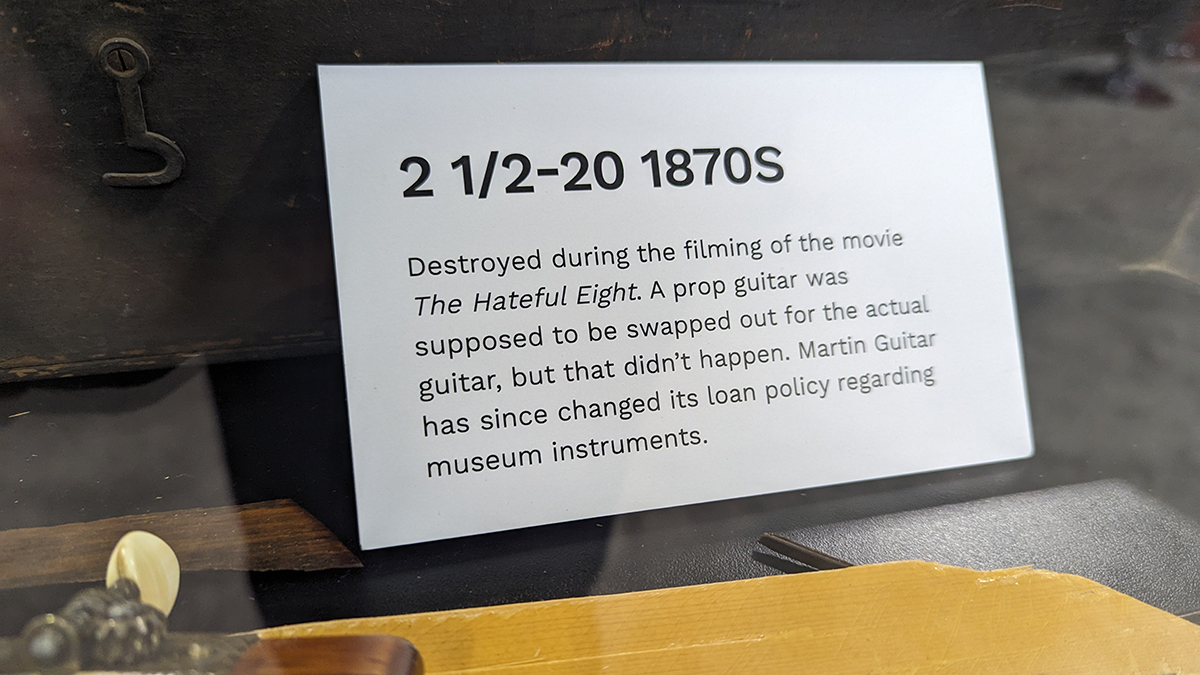NAMM 2024: Remember that priceless Martin that Kurt Russell smashed on the Hateful Eight set? Well, it’s just been put on public display for the first time ever

NAMM 2024: Martin has been busy ushering in a suite of ultra-refined acoustic guitars this week – look no further than its all-new Inception GPCE platform – but the Martin model that has perhaps grabbed our attention the most this week is one that arrived to the Anaheim Convention Center in pieces.
Yes, that might sound slightly unhinged, but there’s a good reason for it: while our intrepid Editor in Chief, Mike, was scouring the show floor for the juiciest gear tidbits, he came across the Martin booth, which had on public display – for the first time ever – the priceless parlor guitar that featured in Quentin Tarantino’s 2015 western epic, The Hateful Eight.
Those familiar with the tale will understand why Martin was forced to preserve the 145-year-old instrument in a solid plexiglass coffin, and will also realize why its debut public appearance is so significant.

For those unaware, the circa 1870-dated guitar was loaned to Tarantino by the Martin Guitar Museum for use in The Hateful Eight, which includes a scene wherein an angered Kurt Russell batters an instrument beyond repair. Unfortunately, an on-set slip-up led to the priceless parlor guitar being used in the place of a prop – and meeting a grizzly end in the process.
That wasn’t how things were supposed to go down: the genuine Martin was only meant to be wielded by Russell’s on-screen partner, Jennifer Jason Leigh, for a short time – as Leigh noodled through Australian folk ballad Jim Jones at Botany Bay – before a replica guitar was supposed to take the Martin’s place.

That would give Russell free rein to rip the instrument from Leigh’s hands, as directed by Tarantino, and use it as a de facto battering ram against one of the set’s pillars.
Sadly, for guitar historians, the swap never happened, the prop replica was never introduced to the set, and Russell – without realizing, it should be said – ended up destroying a piece of music history beyond repair.
All the latest guitar news, interviews, lessons, reviews, deals and more, direct to your inbox!

“There were six doubles made,” the film’s sound mixer Mark Ulano recalled (via Insider) at the time. “The guitar was from the 1870s and was priceless. What was supposed to happen was we were supposed to go up to that point, cut, and trade guitars and smash the double.”
For his part, Russell was egged on by some especially enthusiastic directing from Tarantino: “On that day, I said, ‘How far do you want me to go?’ [Tarantino] said, ‘Just go until I say stop.’ I said, ‘So if you don’t say stop I smash the guitar?’ He said, ‘Yep, great, just keep going.’”
Martin, obviously, was absolutely furious – so angry, in fact, it ended up changing its loan policy: from that point on, it would not, under any circumstance, loan a guitar from its museum to a film production.
That’s what makes this display so significant. After the guitar was smashed, no one knew what happened to it. Martin was forced to deny it had been repaired – despite anecdotal evidence to suggest otherwise – and the battered remains of the priceless parlor fell off the radar.
But they are back, and what’s more, Martin is set to release a short documentary charting the tragic fate of the historic 1870s model at some point in the future. We’re waiting on an official release date for that, so watch this space…
To keep up to date with all gear releases ahead of NAMM 2024, head over to our guide to the latest NAMM 2024 news.

Matt is the GuitarWorld.com News Editor, and has been writing and editing for the site for five years. He has a Masters in the guitar, a degree in history, and has spent the last 19 years playing everything from blues and jazz to indie and pop. During his GW career, he’s interviewed Peter Frampton, Zakk Wylde, Tosin Abasi, Matteo Mancuso and more, and has profiled the CEOs of Guitar Center and Fender.
When he’s not combining his passion for writing and music during his day job, Matt performs with indie rock duo Esme Emerson, and has previously opened for the likes of Ed Sheeran, Keane, Japanese House and Good Neighbours.
